

Compact Muon Solenoid
LHC, CERN
| CMS-PAS-HIN-21-014 | ||
| Constraining bottom quark energy loss and hadronization with B+ and B0s nuclear modification factors in pp and PbPb collisions at 5.02 TeV with CMS | ||
| CMS Collaboration | ||
| 18 September 2023 | ||
| Abstract: The CMS Collaboration reports on the production yields of B0s and B+ mesons in proton-proton (pp) collisions recorded in 2017 at the CERN LHC with a center-of-mass energy of 5.02 TeV. Utilizing an integrated luminosity of 302.3 pb−1, the analysis focuses on the exclusive decay channels B0s→J/ψ(μ+μ−)ϕ(K+K−) and B+→J/ψ(μ+μ−)K+ in a transverse momentum (pT) range of 7-50 GeV/c and a rapidity interval |y|<2.4. The measured pT-differential cross sections of B+ and B0s in pp collisions are well-described by fixed-order plus next-to-leading logarithm calculations. Combining with the previous measurements in lead-lead collisions at the same center of mass, we measure the nuclear modification factor, RAA, of the B+ mesons. The RAA of B+ is significantly lower than unity, while B0s data hint at a larger RAA than that of B+. The B+ RAA is compatible with the RAA of charged hadrons and D0 mesons in the intermediate pT region, while a hint of a smaller suppression is observed for pT< 10 GeV/c. The RAA data from B+ and B0s are also compared to theoretical calculations, providing constraints on the mechanism of beauty quark energy loss and hadronization in the quark-gluon plasma. | ||
|
Links:
CDS record (PDF) ;
CADI line (restricted) ;
These preliminary results are superseded in this paper, Submitted to JHEP. The superseded preliminary plots can be found here. |
||
| Figures | |
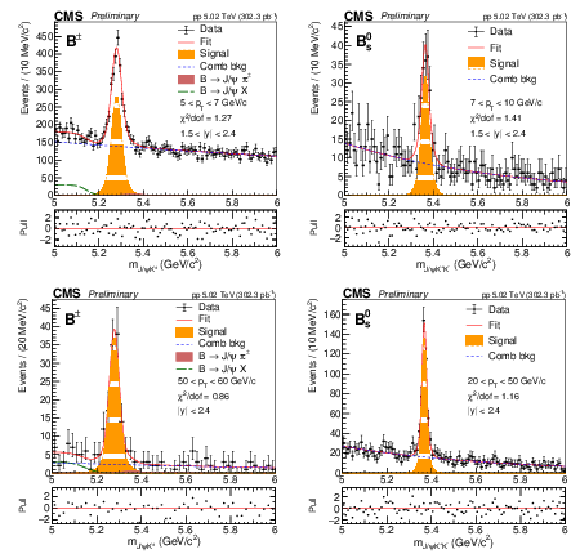
png pdf |
Figure 1:
Invariant mass distributions of B+ (left) and B0s (right) candidates, for the lowest (upper) and highest (lower) pT bins in pp collisions at √s= 5.02 TeV. The lower panels show the pulls, calculated as the difference between the data points and the fit result, divided by the uncertainty in data. |
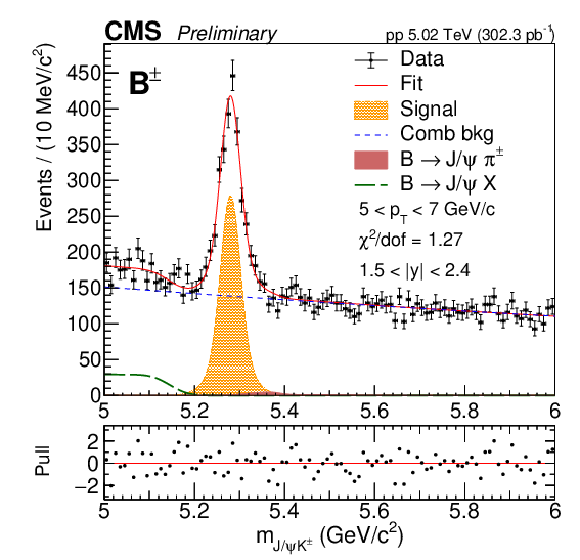
png pdf |
Figure 1-a:
Invariant mass distributions of B+ (left) and B0s (right) candidates, for the lowest (upper) and highest (lower) pT bins in pp collisions at √s= 5.02 TeV. The lower panels show the pulls, calculated as the difference between the data points and the fit result, divided by the uncertainty in data. |
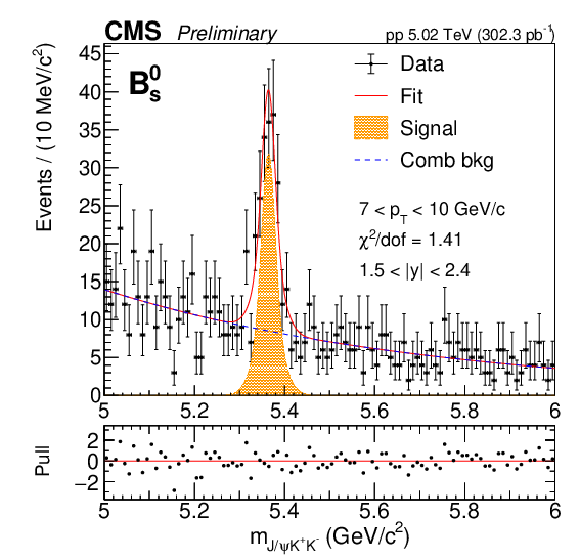
png pdf |
Figure 1-b:
Invariant mass distributions of B+ (left) and B0s (right) candidates, for the lowest (upper) and highest (lower) pT bins in pp collisions at √s= 5.02 TeV. The lower panels show the pulls, calculated as the difference between the data points and the fit result, divided by the uncertainty in data. |
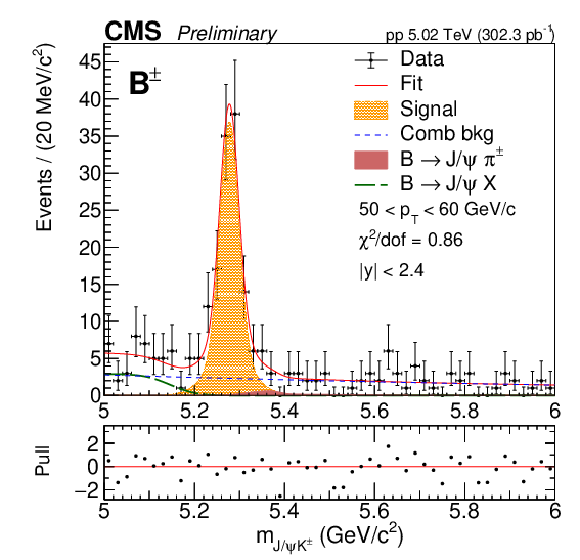
png pdf |
Figure 1-c:
Invariant mass distributions of B+ (left) and B0s (right) candidates, for the lowest (upper) and highest (lower) pT bins in pp collisions at √s= 5.02 TeV. The lower panels show the pulls, calculated as the difference between the data points and the fit result, divided by the uncertainty in data. |
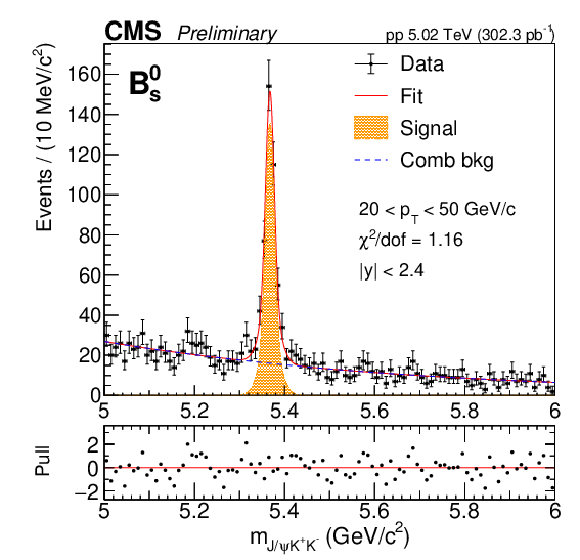
png pdf |
Figure 1-d:
Invariant mass distributions of B+ (left) and B0s (right) candidates, for the lowest (upper) and highest (lower) pT bins in pp collisions at √s= 5.02 TeV. The lower panels show the pulls, calculated as the difference between the data points and the fit result, divided by the uncertainty in data. |
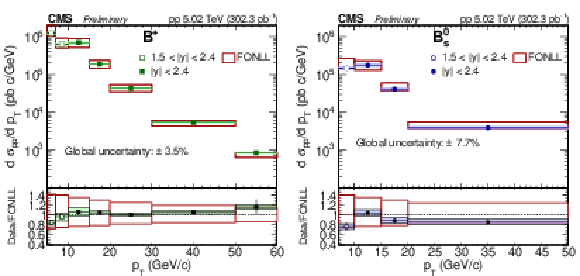
png pdf |
Figure 2:
The pT-differential cross section of B+ (left) and B0s (right) mesons in pp collisions at √s= 5.02 TeV. The vertical bars (shaded boxes) correspond to statistical (systematic) uncertainties. The global systematic uncertainty includes uncertainties in the integrated luminosity and the external branching fractions. The comparison with the calculation from FONLL (open boxes) is also shown. The bottom panels show that the measured cross sections deviate from the FONLL calculations by less than 20%, and they are consistent within uncertainty. |
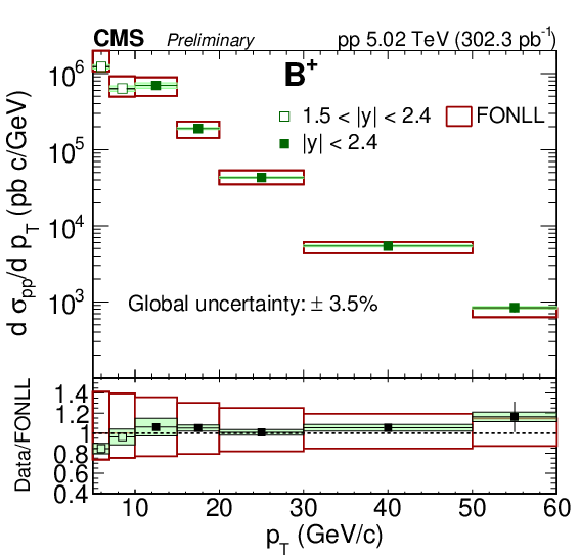
png pdf |
Figure 2-a:
The pT-differential cross section of B+ (left) and B0s (right) mesons in pp collisions at √s= 5.02 TeV. The vertical bars (shaded boxes) correspond to statistical (systematic) uncertainties. The global systematic uncertainty includes uncertainties in the integrated luminosity and the external branching fractions. The comparison with the calculation from FONLL (open boxes) is also shown. The bottom panels show that the measured cross sections deviate from the FONLL calculations by less than 20%, and they are consistent within uncertainty. |
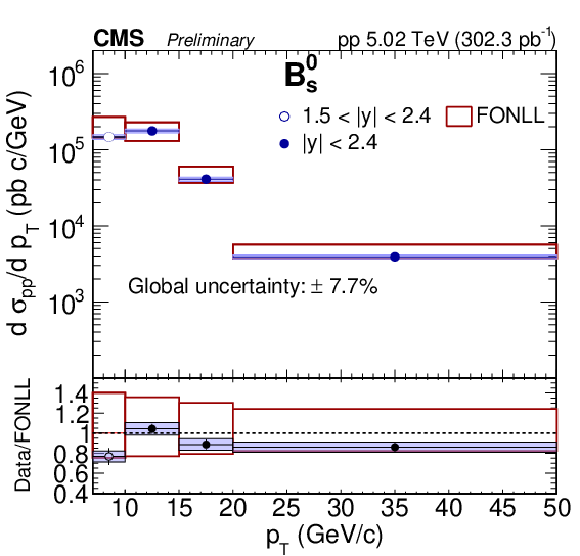
png pdf |
Figure 2-b:
The pT-differential cross section of B+ (left) and B0s (right) mesons in pp collisions at √s= 5.02 TeV. The vertical bars (shaded boxes) correspond to statistical (systematic) uncertainties. The global systematic uncertainty includes uncertainties in the integrated luminosity and the external branching fractions. The comparison with the calculation from FONLL (open boxes) is also shown. The bottom panels show that the measured cross sections deviate from the FONLL calculations by less than 20%, and they are consistent within uncertainty. |
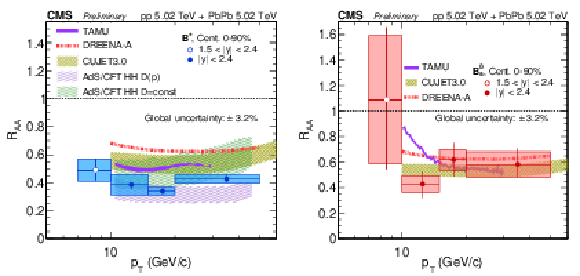
png pdf |
Figure 3:
The pT dependence of the nuclear modification factor of B+ (left) and B0s (right) mesons in PbPb collisions at √sNN= 5.02 TeV. The vertical bars (boxes) correspond to statistical (systematic) uncertainties. The global systematic uncertainty comprises the uncertainties in luminosity, TAA and the number of minimum-bias events [48]. For B+, four theoretical calculations are also shown for comparison: TAMU [75,24], DREENA-A [70,71], CUJET3.0 [72,73,74], and AdS/CFT HH [76,77] with the diffusion coefficient either dependent or independent of the quark momentum. For B0s, three theoretical calculations are shown for comparison: TAMU [75,24], DREENA-A [70,71], and CUJET3.0 [72,73,74]. The line width of the theoretical calculation from Refs. [75,24] indicates the uncertainty in the total b quark coalescence probability (no shadowing is applied). The rapidity range is |y|< 2.4 for all the theory predictions. |
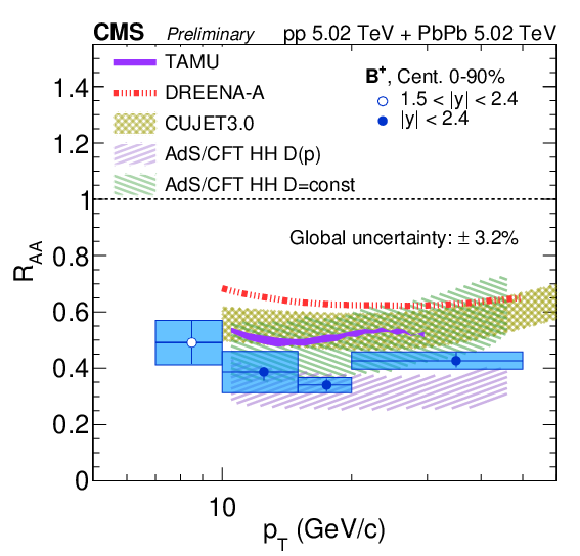
png pdf |
Figure 3-a:
The pT dependence of the nuclear modification factor of B+ (left) and B0s (right) mesons in PbPb collisions at √sNN= 5.02 TeV. The vertical bars (boxes) correspond to statistical (systematic) uncertainties. The global systematic uncertainty comprises the uncertainties in luminosity, TAA and the number of minimum-bias events [48]. For B+, four theoretical calculations are also shown for comparison: TAMU [75,24], DREENA-A [70,71], CUJET3.0 [72,73,74], and AdS/CFT HH [76,77] with the diffusion coefficient either dependent or independent of the quark momentum. For B0s, three theoretical calculations are shown for comparison: TAMU [75,24], DREENA-A [70,71], and CUJET3.0 [72,73,74]. The line width of the theoretical calculation from Refs. [75,24] indicates the uncertainty in the total b quark coalescence probability (no shadowing is applied). The rapidity range is |y|< 2.4 for all the theory predictions. |
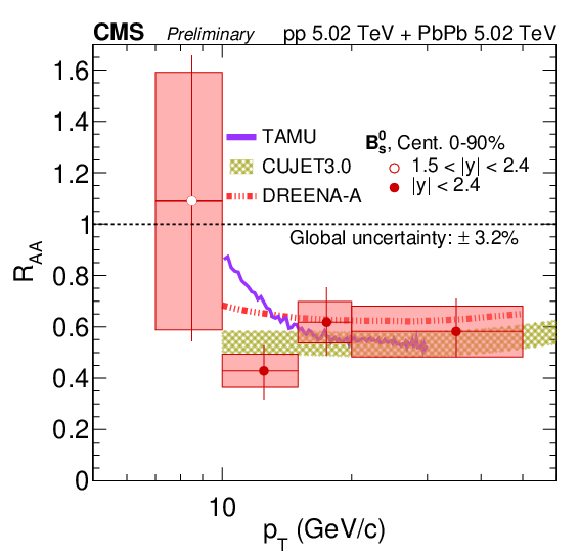
png pdf |
Figure 3-b:
The pT dependence of the nuclear modification factor of B+ (left) and B0s (right) mesons in PbPb collisions at √sNN= 5.02 TeV. The vertical bars (boxes) correspond to statistical (systematic) uncertainties. The global systematic uncertainty comprises the uncertainties in luminosity, TAA and the number of minimum-bias events [48]. For B+, four theoretical calculations are also shown for comparison: TAMU [75,24], DREENA-A [70,71], CUJET3.0 [72,73,74], and AdS/CFT HH [76,77] with the diffusion coefficient either dependent or independent of the quark momentum. For B0s, three theoretical calculations are shown for comparison: TAMU [75,24], DREENA-A [70,71], and CUJET3.0 [72,73,74]. The line width of the theoretical calculation from Refs. [75,24] indicates the uncertainty in the total b quark coalescence probability (no shadowing is applied). The rapidity range is |y|< 2.4 for all the theory predictions. |
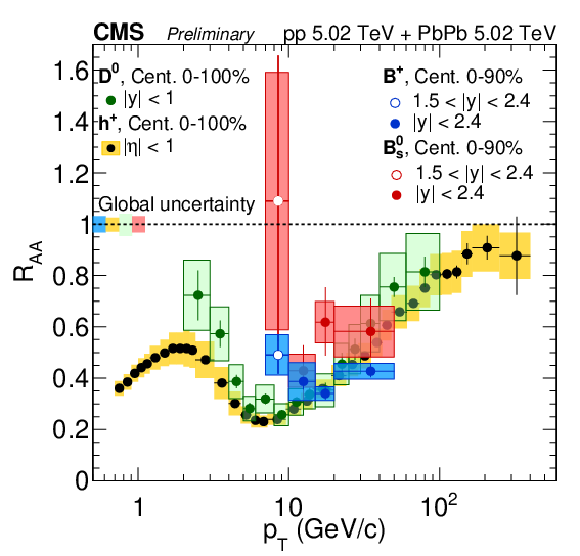
png pdf |
Figure 4:
Comparison of the nuclear modification factor of B+ and B0s mesons with D0 mesons [80] and charged hadrons [62] in PbPb collisions at √sNN= 5.02 TeV. The global systematic uncertainties, depicted in shaded boxes around RAA= 1, comprise the uncertainties in TAA, the number of minimum-bias events, and the luminosity in pp collisions. |
| Tables | |

png pdf |
Table 1:
Summary of the percentage systematic uncertainties for the B+ cross section as a function of pT. The systematic uncertainties in luminosity and branching fractions are global uncertainties that are applied equally to all pT bins. The systematic uncertainty in muon efficiency is found not to have a significnat effect. |

png pdf |
Table 2:
Summary of the percentage systematic uncertainties for the B0s cross section as a function of pT. The systematic uncertainties in luminosity and branching fractions are global uncertainties that are applied equally to all pT bins. |
| Summary |
| In summary, the differential cross sections of B+ and B0s mesons as a function of transverse momentum (pT) in proton-proton (pp) collisions at √s= 5.02 TeV have been measured with the CMS detector at the LHC. The mesons are reconstructed via the exclusive decay channels B+→J/ψ(μ+μ−)K+ and B0s→J/ψ(μ+μ−)ϕ(K+K−) in the transverse momentum intervals 5 <pT< 60 GeV/c and 7 <pT< 50 GeV/c for B+ and B0s, respectively. The measured pT-differential cross sections of B+ and B0s in pp collisions are well-described by fixed-order plus next-to-leading logarithm calculations. The nuclear modification factors, RAA, of B+ are significantly lower than unity at pT> 10 GeV/c, while at low pT, the B0s hints at a larger RAA than that of B+. The RAA data from B+ and B0s are also compared to theoretical calculations, providing constraining power on the mechanism of beauty quark energy loss and hadronization in the quark-gluon plasma. The results are also compared to charm and light flavor hadrons. The B+RAA is compatible with the RAA of charged hadrons and D0 in the intermediate pT region and a hint of a smaller suppression is observed for pT< 10 GeV/c. |
| References | ||||
| 1 | F. Karsch and E. Laermann | Thermodynamics and in-medium hadron properties from lattice QCD | in Quark-Gluon Plasma III, 2003 | hep-lat/0305025 |
| 2 | W. Busza, K. Rajagopal, and W. van der Schee | Heavy ion collisions: the big picture, and the big questions | Ann. Rev. Nucl. Part. Sci. 68 (2018) 339 | 1802.04801 |
| 3 | E . V. Shuryak | Theory of hadronic plasma | Sov. Phys. JETP 47 (1978) 212 | |
| 4 | J. C. Collins and M. J. Perry | Superdense matter: neutrons or asymptotically free quarks? | PRL 34 (1975) 1353 | |
| 5 | A. Andronic et al. | Heavy-flavour and quarkonium production in the LHC era: from proton-proton to heavy-ion collisions | EPJC 76 (2016) 107 | 1506.03981 |
| 6 | X. Dong, Y.-J. Lee, and R. Rapp | Open heavy-flavor production in heavy-ion collisions | Ann. Rev. Nucl. Part. Sci. 69 (2019) 417 | 1903.07709 |
| 7 | L. Apolinário, Y.-J. Lee, and M. Winn | Heavy quarks and jets as probes of the QGP | Prog. Part. Nucl. Phys. 127 (2022) 103990 | 2203.16352 |
| 8 | J. D. Bjorken | Energy loss of energetic partons in quark-gluon plasma: possible extinction of high pT jets in hadron-hadron collisions | Fermilab, 1982 PUB 82-059-THY |
|
| 9 | R. Baier, D. Schiff, and B. G. Zakharov | Energy loss in perturbative QCD | Ann. Rev. Nucl. Part. Sci. 50 (2000) 37 | hep-ph/0002198 |
| 10 | CMS Collaboration | Observation and studies of jet quenching in PbPb collisions at √sNN= 2.76 TeV | Phys. Rev. C 84 (2011) 024906 | CMS-HIN-10-004 1102.1957 |
| 11 | ATLAS Collaboration | Observation of a centrality-dependent dijet asymmetry in lead-lead collisions at √sNN= 2.76 TeV with the ATLAS detector at the LHC | PRL 105 (2010) 252303 | 1011.6182 |
| 12 | A. Beraudo et al. | Extraction of heavy-flavor transport coefficients in QCD matter | Nucl. Phys. A 979 (2018) 21 | 1803.03824 |
| 13 | ALICE Collaboration | K0S and Λ production in PbPb collisions at √sNN= 2.76 TeV | PRL 111 (2013) 222301 | 1307.5530 |
| 14 | STAR Collaboration | Strangeness enhancement in Cu+Cu and Au+Au collisions at √sNN= 200 GeV | PRL 108 (2012) 072301 | 1107.2955 |
| 15 | STAR Collaboration | Energy and system size dependence of ϕ meson production in Cu+Cu and Au+Au collisions | PLB 673 (2009) 183 | 0810.4979 |
| 16 | BRAHMS Collaboration | Kaon and pion production in central Au+Au collisions at √sNN= 62.4 GeV | PLB 687 (2010) 36 | 0911.2586 |
| 17 | STAR Collaboration | Collision energy dependence of moments of net-kaon multiplicity distributions at RHIC | PLB 785 (2018) 551 | 1709.00773 |
| 18 | PHENIX Collaboration | ϕ meson production in the forward/backward rapidity region in Cu+Au collisions at √sNN= 200 GeV | Phys. Rev. C 93 (2016) 024904 | 1509.06337 |
| 19 | ALICE Collaboration | Enhanced production of multi-strange hadrons in high-multiplicity proton-proton collisions | Nature Phys. 13 (2017) 535 | 1606.07424 |
| 20 | J. Rafelski and B. Müller | Strangeness production in the quark-gluon plasma | PRL 48 (1982) 1066 | |
| 21 | D. Molnar and S. A. Voloshin | Elliptic flow at large transverse momenta from quark coalescence | PRL 91 (2003) 092301 | nucl-th/0302014 |
| 22 | V. Greco, C. M. Ko, and P. Levai | Parton coalescence at RHIC | Phys. Rev. C 68 (2003) 034904 | nucl-th/0305024 |
| 23 | V. Greco, C. M. Ko, and R. Rapp | Quark coalescence for charmed mesons in ultrarelativistic heavy ion collisions | PLB 595 (2004) 202 | nucl-th/0312100 |
| 24 | M. He, R. J. Fries, and R. Rapp | Heavy flavor at the large hadron collider in a strong coupling approach | PLB 735 (2014) 445 | 1401.3817 |
| 25 | ALICE Collaboration | Measurement of D0, D+, D∗+ and D+s production in PbPb collisions at √sNN= 5.02 TeV | JHEP 10 (2018) 174 | 1804.09083 |
| 26 | CMS Collaboration | Measurement of B0s meson production in pp and PbPb collisions at √sNN= 5.02 TeV | PLB 796 (2019) 168 | CMS-HIN-17-008 1810.03022 |
| 27 | CMS Collaboration | Observation of the B+c meson in PbPb and pp collisions at √sNN= 5.02 TeV and measurement of its nuclear modification factor | no.~25, 252301, 2022 PRL 128 (2022) |
CMS-HIN-20-004 2201.02659 |
| 28 | CMS Collaboration | Evidence for X(3872) in PbPb collisions and studies of its prompt production at √sNN= 5.02 TeV | no.~3, 03, 2022 PRL 128 (2022) |
CMS-HIN-19-005 2102.13048 |
| 29 | CMS Collaboration | Luminosity measurement in proton-proton collisions at 5.02 TeV in 2017 at CMS | CMS Physics Analysis Summary, 2021 CMS-PAS-LUM-19-001 |
CMS-PAS-LUM-19-001 |
| 30 | CMS Collaboration | Measurement of the B+ production cross section in pp\ collisions at √s= 7 TeV | PRL 106 (2011) 112001 | CMS-BPH-10-004 1101.0131 |
| 31 | CMS Collaboration | Measurement of the B0s production cross section in pp collisions at √s= 7 TeV | PRL 106 (2011) 252001 | CMS-BPH-10-005 1104.2892 |
| 32 | CMS Collaboration | Measurement of the B0s production cross section with B0s→J/ψϕ decays in pp collisions at √s= 7 TeV | PRD 84 (2011) 052008 | CMS-BPH-10-013 1106.4048 |
| 33 | ATLAS Collaboration | Measurement of the differential cross-section of B+ meson production in pp collisions at √s= 7 TeV at ATLAS | JHEP 10 (2013) 042 | 1307.0126 |
| 34 | LHCb Collaboration | Measurement of the B± production cross-section in pp collisions at √s= 7 TeV | JHEP 04 (2012) 093 | 1202.4812 |
| 35 | LHCb Collaboration | Measurement of B meson production cross-sections in proton-proton collisions at √s= 7 TeV | JHEP 08 (2013) 117 | 1306.3663 |
| 36 | LHCb Collaboration | Measurement of b-hadron production fractions in 7 TeV pp collisions | PRD 85 (2012) 032008 | 1111.2357 |
| 37 | LHCb Collaboration | Measurements of B+c production and mass with the B+c→J/ψπ+ decay | PRL 109 (2012) 232001 | 1209.5634 |
| 38 | CMS Collaboration | Measurement of the ratio of the production cross sections times branching fractions of B±c→J/ψπ± and B±→J/ψK± and B(B±c→J/ψπ±π±π∓)/B(B±c→J/ψπ±) in pp collisions at √s= 7 TeV | JHEP 01 (2015) 063 | CMS-BPH-12-011 1410.5729 |
| 39 | LHCb Collaboration | Study of the production of Λ0b and ¯B0 hadrons in pp collisions and first measurement of the Λ0b→J/ψpK− branching fraction | Chin. Phys. C 40 (2016) 011001 | 1509.00292 |
| 40 | LHCb Collaboration | Measurement of B+c production in proton-proton collisions at √s= 8 TeV | PRL 114 (2015) 132001 | 1411.2943 |
| 41 | ATLAS Collaboration | Measurement of the relative B±c/B± production cross section with the ATLAS detector at √s= 8 TeV | PRD 104 (2021) 012010 | 1912.02672 |
| 42 | CMS Collaboration | Measurement of the total and differential inclusive B+ hadron cross sections in pp collisions at √s= 13 TeV | PLB 771 (2017) 435 | CMS-BPH-15-004 1609.00873 |
| 43 | LHCb Collaboration | Measurement of the B± production cross-section in pp collisions at √s= 7 and 13 TeV | JHEP 12 (2017) 026 | 1710.04921 |
| 44 | LHCb Collaboration | Measurement of the B−c meson production fraction and asymmetry in 7 and 13 TeV pp collisions | PRD 100 (2019) 112006 | 1910.13404 |
| 45 | CMS Collaboration | Study of B meson production in pPb collisions at √sNN= 5.02 TeV using exclusive hadronic decays | PRL 116 (2016) 032301 | CMS-HIN-14-004 1508.06678 |
| 46 | LHCb Collaboration | Measurement of B+, B0s and Λ0b production in pPb collisions at √sNN= 8.16 TeV | PRD 99 (2019) 052011 | 1902.05599 |
| 47 | CMS Collaboration | Measurement of the B± meson nuclear modification factor in PbPb collisions at √sNN= 5.02 TeV | PRL 119 (2017) 152301 | CMS-HIN-16-011 1705.04727 |
| 48 | CMS Collaboration | Observation of B0s mesons and measurement of the B0s/B+ yield ratio in PbPb collisions at √sNN= 5.02 TeV | PLB 829 (2022) 137062 | CMS-HIN-19-011 2109.01908 |
| 49 | M. Cacciari, M. Greco, and P. Nason | The pT spectrum in heavy-flavour hadroproduction | JHEP 05 (1998) 007 | hep-ph/9803400 |
| 50 | M. Cacciari and P. Nason | Charm cross sections for the Tevatron Run II | JHEP 09 (2003) 006 | hep-ph/0306212 |
| 51 | M. Cacciari et al. | Theoretical predictions for charm and bottom production at the LHC | JHEP 10 (2012) 137 | 1205.6344 |
| 52 | CMS Tracker Group Collaboration | The CMS phase-1 pixel detector upgrade | JINST 16 (2021) P02027 | 2012.14304 |
| 53 | CMS Collaboration | Track impact parameter resolution for the full pseudo rapidity coverage in the 2017 dataset with the CMS phase-1 pixel detector | CMS Detector Performance Summary CMS-DP-2020-049, 2020 CDS |
|
| 54 | CMS Collaboration | Performance of the CMS muon detector and muon reconstruction with proton-proton collisions at √s= 13 TeV | JINST 13 (2018) P06015 | CMS-MUO-16-001 1804.04528 |
| 55 | T. Sjöstrand et al. | An introduction to PYTHIA 8.2 | Comput. Phys. Commun. 191 (2015) 159 | 1410.3012 |
| 56 | CMS Collaboration | Extraction and validation of a new set of CMS PYTHIA8 tunes from underlying-event measurements | EPJC 80 (2020) 4 | CMS-GEN-17-001 1903.12179 |
| 57 | CMS Collaboration | Event generator tunes obtained from underlying event and multiparton scattering measurements | EPJC 76 (2016) 155 | CMS-GEN-14-001 1512.00815 |
| 58 | J. Allison et al. | Recent developments in GEANT4 | NIMA 835 (2016) 186 | |
| 59 | D. J. Lange | The EvtGen particle decay simulation package | NIM A 462 (2001) 152 | |
| 60 | E. Barberio, B. van Eijk, and Z. Was | PHOTOS: A universal Monte Carlo for QED radiative corrections in decays | Comput. Phys. Commun. 66 (1991) 115 | |
| 61 | CMS Collaboration | The CMS trigger system | JINST 12 (2017) P01020 | CMS-TRG-12-001 1609.02366 |
| 62 | CMS Collaboration | Charged-particle nuclear modification factors in PbPb and pPb collisions at √sNN= 5.02 TeV | JHEP 04 (2017) 039 | CMS-HIN-15-015 1611.01664 |
| 63 | CMS Collaboration | Study of jet quenching with isolated-photon+jet correlations in PbPb and pp collisions at √sNN= 5.02 TeV | PLB 785 (2018) 14 | CMS-HIN-16-002 1711.09738 |
| 64 | CMS Collaboration | Transverse momentum and pseudorapidity distributions of charged hadrons in pp collisions at √s= 0.9 and 2.36 TeV | JHEP 02 (2010) 041 | CMS-QCD-09-010 1002.0621 |
| 65 | Particle Data Group Collaboration | Review of particle physics | PRD 98 (2018) 030001 | |
| 66 | H. Voss, A. Höcker, J. Stelzer, and F. Tegenfeldt | TMVA -- the toolkit for multivariate data analysis | in XIth International Workshop on Advanced Computing and Analysis Techniques in Physics Research (ACAT), 2009 link |
physics/0703039 |
| 67 | CMS Collaboration | Upsilon production cross-section in pp collisions at √s= 7 TeV | PRD 83 (2011) 112004 | CMS-BPH-10-003 1012.5545 |
| 68 | M. Pivk and F. R. Le Diberder | SPlot: a statistical tool to unfold data distributions | NIM A 555 (2005) 356 | physics/0402083 |
| 69 | CMS Collaboration | Tracking POG results for pion efficiency with the D* meson using data from 2016 and 2017 | CMS Detector Performance Summary CMS-DP-2018-050, 2018 CDS |
|
| 70 | D. Zigic et al. | Importance of higher harmonics and v4 puzzle in quark-gluon plasma tomography | Phys. Rev. C 10 (2022) 044909 | 2208.09886 |
| 71 | D. Zigic et al. | DREENA-A framework as a QGP tomography tool | Front. in Phys. 10 (2022) 957019 | 2110.01544 |
| 72 | J. Xu, J. Liao, and M. Gyulassy | Bridging soft-hard transport properties of quark-gluon plasmas with CUJET3.0 | JHEP 02 (2016) 169 | 1508.00552 |
| 73 | J. Xu, J. Liao, and M. Gyulassy | Consistency of perfect fluidity and jet quenching in semi-quark-gluon monopole plasmas | Chin. Phys. Lett. 32 (2015) 092501 | 1411.3673 |
| 74 | J. Xu, A. Buzzatti, and M. Gyulassy | Azimuthal jet flavor tomography with CUJET2.0 of nuclear collisions at RHIC and LHC | JHEP 08 (2014) 063 | 1402.2956 |
| 75 | M. He, R. J. Fries, and R. Rapp | Heavy-quark diffusion and hadronization in quark-gluon plasma | Phys. Rev. C 86 (2012) 014903 | 1106.6006 |
| 76 | W. A. Horowitz | Fluctuating heavy quark energy loss in a strongly coupled quark-gluon plasma | PRD 91 (2015) 085019 | 1501.04693 |
| 77 | R. Hambrock and W. A. Horowitz | AdS/CFT predictions for azimuthal and momentum correlations of bˉb pairs in heavy ion collisions | link | 1703.05845 |
| 78 | M. Rohrmoser, P. B. Gossiaux, T. Gousset, and J. Aichelin | Constraining in-medium heavy-quark energy-loss mechanisms via angular correlations between heavy and light mesons | J. Phys. Conf. Ser. 779 (2017) 012032 | 1611.01854 |
| 79 | S. Cao, G.-Y. Qin, and S. A. Bass | Heavy flavor dynamics in QGP and hadron gas | in XXIV International Conference on Ultrarelativistic Nucleus-Nucleus Collisions, 2014 Nucl. Phys. A 931 (2014) 569 |
1408.0503 |
| 80 | CMS Collaboration | Nuclear modification factor of D0 mesons in PbPb collisions at √sNN= 5.02 TeV | PLB 782 (2018) 474 | CMS-HIN-16-001 1708.04962 |

|
Compact Muon Solenoid LHC, CERN |

|

|

|

|

|

|